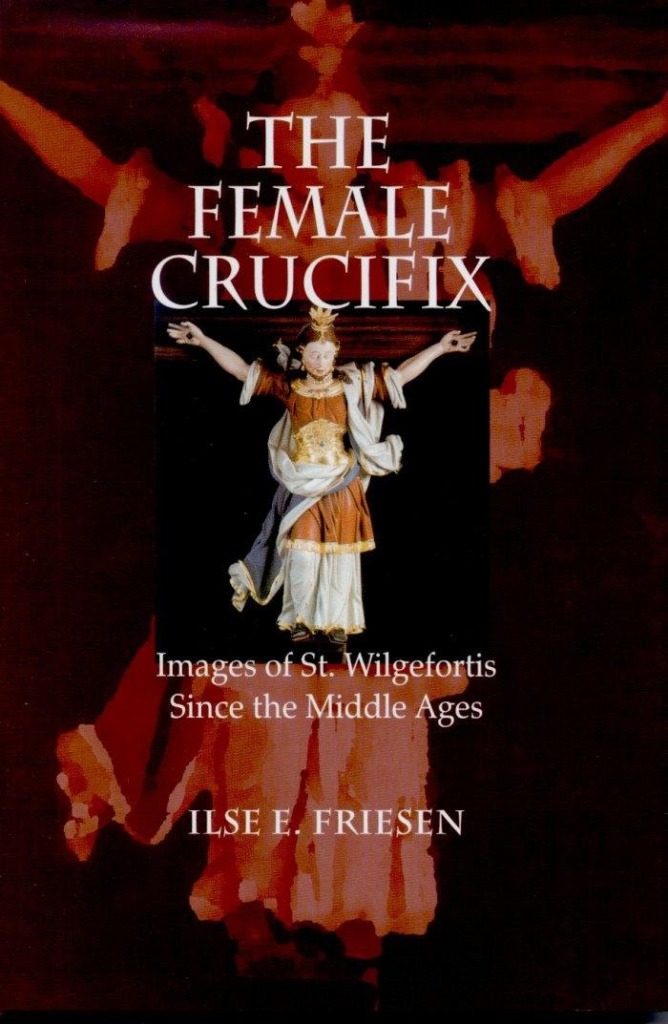Bearded Ladies and Broken Beliefs
Not having access to a dedicated woodshop has meant that I’m finding creative solutions for the shapes and sizes of wood that I need to build the base and four 42” high columns for The Bearded Lady diorama.
Progress has been slow, but forward moving. On one hand, the snail’s pace of this piece has been agonizing. On the other, it’s meant that I’ve had bonus time to enrich the work by adding more details and contextual layers. Have I mentioned lately how much I love research?
Originally planning on featuring only historic male beards in The Bearded Lady’s retail store setting, I’ve decided to include two important, historical bearded ladies.
One of these is St. Wilgefortis. I first came across her narrative while reading Canadian author Robertson Davies’ Deptford Trilogy. (Spoiler alert: if you’re thinking of reading the books, don’t read farther than the first paragraph of this link!)
Known as the unofficial patron Saint of bearded ladies and the LGBQT community (or, rather, the patron UN-Saint…more on that later), Saint Wilgefortis is thought to have come into consciousness as a folk saint in the 14th century.
Her story goes something like this:
Wilgefortis, a devout Christian, had been ordered to wed a pagan king by her father, the King of Portugal (also, incidentally, a pagan). On the night before the wedding, Wilgefortis took a vow of virginity and prayed desperately, asking to be made repulsive so that her fiance would no longer wish to wed her. The next morning Wilgefortis awoke with a full, lush beard. Her plea to the higher powers worked, but her angry father crucified her. Voila, another virgin martyr.
According to Wikipedia, versions of Saint Wilgefortis (assumed to have been derived from “virgo fortis”, “courageous virgin”, Latin) are found across Europe:
- Uncumber (“escaper”, England)
- Ontkommer (“one who avoids something painful”, Netherlands)
- Kummernis (“grief” or “anxiety”, Germany)
- Frasobliwa (“sorrowful”, Poland)
- Liberata (“liberated”, Italy)
- Librada (“liberated”, Spain)
- Debarras (“riddance”, France)
For some reason, Wilgefortis was officially removed from the Vatican calendar in 1969. Must have been all that hippy free-love and drug-induced mind expansion that frightened the Catholic church into abolishing a strong-willed, ambiguous saint.
The Bearded Lady is a special archetype for me, precisely because of her ambiguous nature.
AMBIGUITY is a key guiding principle of my studio practice. I’ve worked hard all my life to change my default, learned attitude of either/or into either/AND by showcasing unconventional bodies in my work. Again and again I’ve returned to the Bearded Lady as a messenger for my ideas:

- 2000: I make a beard out of my then boyfriend’s hair.
- 2003: The Bearded Lady materializes as the second completed sculpture in my highly populated Will the Real Slim Shady Please Stand Up? series (see The Bearded Lady Shaves Her Head).
- 2005: I mobilize the beard in a public gender performance called “The Bearding” (see photos and read my statement about it in this archived blog post).
- 2015: I begin work on a series of characters inspired by traditional sideshow archetypes. The Bearded Lady figure is finished in 2016.
- 2019: I decide to construct elaborate mixed media environments for the sideshow series. I finish a sketch of the diorama for The Bearded Lady.
- 2020: I start construction on the 1:1 scale mock-up of the Bearded Lady diorama.
- 2021: I begin construction on the master diorama for The Bearded Lady.
Fueled by a marvelous petite tome titled The Female Crucifix, I’m learning more about this folk saint and her place in the context of art history. I find it imperative that Wilgefortis be cast in the starring role, embodied in the main, textile-based figure.

The second historical bearded lady I’m referencing in the diorama is Hatshepsut – the Queen who would be King.
Hatshepsut ruled Egypt as an interim Pharaoh (c 1447- 1458BC) while her “nephew”, Thutmose III was too young to reign (the rightful child heir was born from Hatshepsut’s husband, Thutmose II and one of his secondary wives, Iset). Hatshepsut held power for 22 years, immortalized in sculptures and reliefs showing her wearing the ceremonial strap-on beard customary to the position of king.

But, just as her pagan father snuffed out Wilgefortis and the Vatican deleted St. Wilgefortis out of its history, so endeavored Hatshepsut’s successor to erase Hatshepsut after her service. King Thutmose III ordered the reproductions of Hatshepsut as a bearded pharaoh to be destroyed and defaced (literally, carvings of her chiseled out of reliefs and beards broken off of statuary).
So…what exactly is it about a woman displaying a physical attribute of masculinity that freaks people out?
Although it seems outdated and childish, old patterns die hard. The instinct to be wary of flora and fauna outside of our ken served an important service in centuries past, saving us from sickness and death. Unfortunately, our prehistoric lizard brains haven’t seemed to keep pace with our civil evolutions. It’s as if there is a belief in a finite cache of power; the only way for feminine bodies to be equally powerful as the male bodies, we must become usurpers, stealing the power away.
But what if power is expansive and infinite? Instead of power being limited, what if it’s a well that is perpetually refilled each time it’s dipped into?
Personally, I’m holding space and illustrating an alternative system or systems where all bodies can safely present as powerful, be they identifying as feminine, masculine, or any point on the evolving sliding-scale of gender.
I hope that my insertion of St. Wilgefortis and Hatshepsut into my art is seen for what it is – an intentional act of restitution and reinstatement of these resilient, transgressive figures into culture.